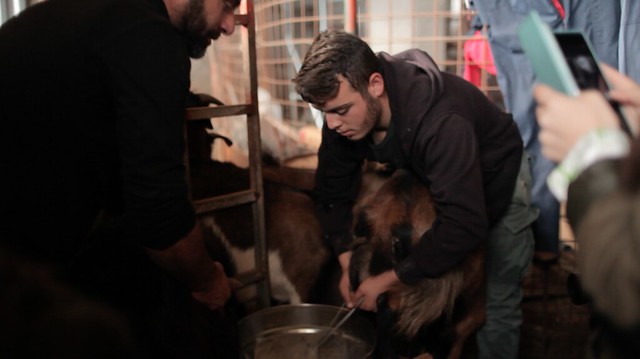Maddie Salters continues her agro-adventure on the island of Crete.
In the high-altitude village of Krana in Mylopotamos, the baying of goats is a common sound. They are a shepherding people, in this part of Crete, and I had the honour and pleasure to meet Father Andreas Kokkinos, one such shepherd who would show me the ropes.
For agro-adventurers interested in working with animals, visiting a Cretan goat farm is really a must. It’s an early day: goats are milked close to sun up, to give them time to feed afterwards in the wild, and to give farmers time to pour their milk into a hand-made stone kiln to produce cheeses. The real highlight of such a visit, however (if not the farm fresh food), is the introduction to an array of animals, and the endless checklist of work to be done. I spent a bright, buzzy morning collecting acorns for pigs, playing with a few fluffy dogs, ducking a harried group of farm peacocks, and plucking eggs from the chickens. Herding the goats (who were painted a bright, psychedelic red to denote their ownership) was easier than I expected– and milking them, much harder! All of this makes a real impact on how much you enjoy the meals that follow: knowing the work that goes into each dish, and appreciating the freshness of the ingrediatens.
On the jagged mountaintop, I learned that adding vinegar to boiled goat’s milk is what produces the cheese: and a fabulous cheese, at that. While normally, goat’s cheese is shaped in wicker baskets and left to mature, fresh-from-the-kiln cheese presents itself as more of a warm and pungent ricotta… perfect for filling dessert parcels of pastry dough with, and drizzling with honey after baking.
Following a hard day of work on the farm (I also managed to fit in a hike and planting a few trees), Greek hospitality once again made itself known: the farmer invited us to a meal at his table for an outdoor meal. Crete has 5000 years of food culture, and has been exploring olives, wine, honey, cheese, herbs, and vinegar for almost as long. So to eat a meal involving all of the above, mostly home-made on Father Kokkinos’ land? Heaven.
I was especially impressed by the Pilafi: a watery, risotto-like rice dish that is cooked in the stock of sheep and goat meat, left behind from cooking a main dish. Extremely buttery and savory, while also having a playful sour note, it was like nothing I had ever tasted before. The home-made wine served alongside it, a strong, amber version of greek ‘raki’ wine, was also delicious, and a bit strong. Most farmers have their own version of the brew, but enquire after it at your own risk!
Best of All: Cinnamon ‘rakomelo’! I was introduced to this honied digestive spirit after my farm meal… and if it’s really meant to be a tonic more than a drink, why say no to a second shot?
Pro Tip: If you get car sick, be sure to bring a bottle of fizzy water with you. The trip up the mountain (if you don’t hike it, which would take the better half of a day) comes with many twists and turns.
Read more posts in Maddie’s Crete Eats series.


























Pingback: Crete Eats: Round Up of Posts